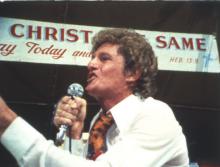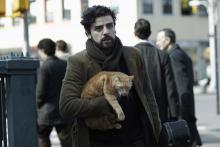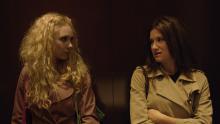Program Notes by Thomas Gladysz
Howard Hawks' A Girl in Every Port is a well-crafted and entertaining "buddy film" widely considered the director's best silent. It's also a film with a special legacy.
A Girl in Every Port features a romantic triangle – a reoccurring motif in many of Hawks' later works. It tells the story of two sailors (Victor McLaglen and Robert Armstrong) and their adventures in various ports of call around the world. Louise Brooks plays Marie (Mam'selle Godiva), a high diver and sideshow siren and the love interest of both sailors. Other girls in other ports of call include Myrna Loy, Sally Rand, Leila Hyams, and Maria Casajuana (the future Maria Alba).
Released by Fox in February of 1928, A Girl in Every Port debuted at the 6,000 seat Roxy Theater in New York City. For days on end, the film played to a packed house. Ads placed by the studio in trade publications claimed it set a "New House Record – and a World Record – with Daily Receipts on February 22 of $29,463." Considering ticket prices of the time, that's a lot of money.
Popular as well as critically acclaimed, the film received good reviews in New York's daily newspapers. The New York Times described it "A rollicking comedy," while the New York Telegram called it "a hit picture." The Morning Telegraph pronounced it a "winner."
The Daily News noted, "Director Howard Hawks has injected several devilish touches in the piece, which surprisingly enough, got by the censors. His treatment of the snappy scenario is smooth and at all times interesting. Victor's great, Armstrong's certainly appreciable, and Louise Brooks is at her loveliest."
Reviewing the premiere, TIME magazine stated, "There are two rollicking sailors in this fractious and excellent comedy. . . . A Girl in Every Port is really What Price Glory? translated from arid and terrestrial irony to marine gaiety of the most salty and miscellaneous nature. Nobody could be more charming than Louise Brooks, that clinging and tender little barnacle from the docks of Marseilles. Director Howard Hawks and his entire cast, especially Robert Armstrong, deserve bouquets and kudos."
A number of critics singled out Brooks. The New York American stated, “Then comes THE woman. She is Louise Brooks, pert, fascinating young creature, who does high and fancy diving for a living. . . . Miss Brooks 'takes' our hero in somewhat the manner that Grant took Richmond. . . . Louise Brooks has a way of making a junior vamp and infantile scarlet lady seem most attractive."
A reviewer for the English Kinematograph Weekly echoed American reviews of the film, and picked up on the film's somewhat different bromance. "Louise Brooks made a charmingly heartless vamp. . . . It has the novelty of a love interest that does not materialize, which is replaced by the friendship between two men."
The film made a bigger splash in France. Writing in 1930 in his "Paris Cinema Chatter" column in the New York Times, Morris Gilbert noted ". . . there are a number of others – mostly American – which have their place as 'classics' in the opinion of the French. . . . They love A Girl in Every Port, which has the added distinction of being practically the only American film which keeps its own English title here." The film enjoyed an extended run in the French capitol, and lingered for decades in the French consciousness.
Writing in Cahiers du Cinéma in 1963, French film archivist Henri Langlois stated, "It seems that A Girl in Every Port was the revelation of the Hawks season at the Museum of Modern Art in New York. For New York audiences of 1962, Louise Brooks suddenly acquired that 'Face of the century' aura she had had, many years ago, for spectators at the Cinema des Ursulines. . . . That is why Blaise Cendrars confided a few years ago that he thought A Girl in Every Port definitely marked the first appearance of contemporary cinema. To the Paris of 1928, which was rejecting expressionism, A Girl in Every Port was a film conceived in the present, achieving an identity of its own by repudiating the past."
Brooks, under contract to Paramount, was loaned to Fox for her role in A Girl in Every Port. Anticipating the female types cast by Hawks in later works, the bobbed-hair actress stands as what might well be the first "Hawksian woman." Years later, the director stated, "I wanted a different type of girl. I hired Louise because she's very sure of herself, she's very analytical, she's very feminine, but she's damn good and sure she's going to do what she wants to do."
Film histories note that A Girl in Every Port ranks as the most significant of Hawks' silent films; additionally, historians claim, it seemingly persuaded G.W. Pabst to cast Louise Brooks in Pandora's Box. Such a claim was likely first made by James Card of the George Eastman House in his 1956 article, "Out of Pandora's Box: Louise Brooks on G. W. Pabst." It was repeated by others, including Brooks herself, in filmed interviews in the 1970's.
In Germany, Pabst came to cast Brooks as Lulu only after a well publicized nationwide search which concluded months after A Girl in Every Port premiered in New York City. Not quite content with a German actress (including, legend has it, Marlene Dietrich), Pabst wrote to Paramount asking after Brooks, then an American starlet. The German director was also in search of a "different type."
Chronologically, the assumption that Pabst saw his Lulu in Hawks' Marie makes sense – Brooks plays a temptress in both films. Records show, however, that Blaue jungens, blonde Madchen (the German title for Hawk's film) was not shown in Germany until December, after production on Pandora's Box was finished.
Could Pabst have seen A Girl in Every Port well prior to its release in Germany? Or, might Pabst have noticed Brooks in one of her earlier American films, like Die Braut am Scheidewege (Just Another Blonde) or Ein Frack Ein Claque Ein Madel (Evening Clothes)? Each were shown in Berlin while Pabst was looking for Lulu, and each received press which highlighted Brooks.
Whatever the answer to this small mystery, A Girl in Every Port remains an entertaining film worthy of greater recognition – not only because it stars Louise Brooks, and not only because it may or may not have led Pabst to cast the actress as Lulu in Pandora's Box.
It's deserving because it is an early work by great director which introduces the themes and characters Hawks would continue to explore throughout his long and distinguished career.
Thomas Gladysz is an arts journalist, silent film enthusiast, and the founding director of the Louise Brooks Society, an online archive and international fan club devoted to the film star. Gladysz has curated exhibits, contributed to books, appeared on television, and introduced the actress's films around the world.










